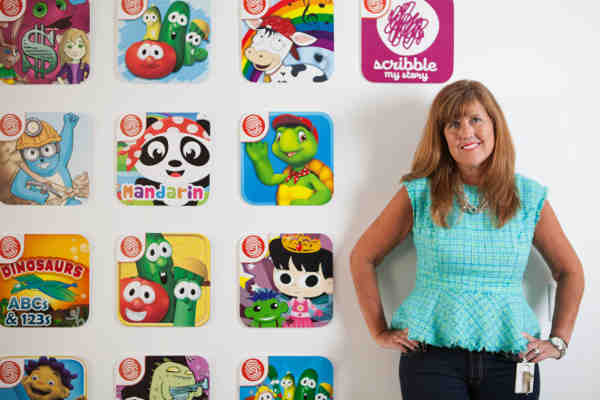Fingerprint Connects Families Using Mobile Content
With an array of play-and-learn apps for families, mobile technology company Fingerprint is in the business of creating stronger bonds between children and their parents.
In the process, the company has established a pervasive ecosystem of app developers, consumers, and brands while leveraging mobile networks to deliver and sell edutainment content across the world.
As Fingerprint has chalked out a plan to develop new games, apps, videos, and e-books targeting families, RMN Digital invited Nancy MacIntyre, CEO of Fingerprint, for an exclusive interview with Rakesh Raman, the managing editor of RMN Digital.
Here’s what she said.
1. Do children really need the deluge of content that is being delivered to them through traditional as well as new media / digital channels?
That’s kind of a philosophical question! How many books, how many games, how many songs, how many creative activities, how many videos is enough (or too much) to inspire a love of learning and curiosity in a child?
It’s true that there is a deluge of content being delivered to families and children. Families experience a torturous ‘hunt and peck’ scenario trying to sift through 150,000 kids’ edutainment apps available in the iOS and Google Play stores.
Parents are busy and don’t often have the time to determine what content is appropriate. That’s one of the reasons why Fingerprint is growing. Parents can go straight to a curated network – either our own, Fingerprint Play, or to our partners.
We partner with brands that parents already know and trust, including Samsung, Sylvan Learning and Astro. Our partnership with Samsung has just begun rolling out over the past months and is launching in SE Asia first under the name Samsung KidsTime.
2. How does Fingerprint business work in terms of content creation, its delivery, and monetization?
At a high level, Fingerprint supports virtually all business models – paid, subscription, or Freemium. This means we can support any consumer offering an enterprise partner desires with a range of appropriate content that meets that model.
We work with developers from around the world who know it is challenging to get their content discovered within app stores. They’re also well aware that curated networks can highlight and promote their apps.
The result is that they profit from the special spotlight they get from being in a reputed network vs. an overcrowded app store, of, yes, 2.7 million choices!
We also created a Content Initiative with Samsung last December to issue a call to developers. Since that time we have received hundreds of terrific app submissions that are under consideration.
Fingerprint, along with content developers, earn a revenue share of what’s sold on its licensed networks (Samsung, Sylvan, Astro, Cricket Media and more).
In addition to a revenue share, Fingerprint also offers its developer partners marketing and technical support to bring their app to an ever-sophisticated kids’ market.
3. How do you define the quality of edutainment content for children and how do you achieve that quality?
We have an evaluation rubric that relates to Educational quality, Fun Factor, Replayability, and Innovation. Think of it like a simple scorecard that determines whether an app “fits” that is evaluated by our Learning Design and Production Team as well as any curriculum specialists that might exists with our partners, such as Sylvan Learning.
We work with developers who have experience and talent in both education and entertainment. Many of whom are accredited with educational organizations and are awarded commendations and awards.
Fantastec (Finland), for example, leverages its expertise in education along with its expertise in video games to create learning games for kids. Tigerface Games (UK) specializes in collaborative, multiplayer learning apps. PowerPlay Labs (US) develops math-based games. And, most recently, we teamed with the creative geniuses from yummico (creators of Blues Clues) to develop a new series that’s ‘good and good for you.’
4. Do you assess the demand for content among children before you supply the content? If yes, what methodology do you follow to study the demand?
As you can imagine, it’s not a perfect science like consumer products! Since we’re primarily focused on learning, we look at trends in education, trends in the app store, successful play patterns and themes on a region and age group basis.
That said, we look for innovation and newness in the market and partner with developers doing fresh and interesting concepts, then evaluate those ideas relative to the trends. Given the relatively low barrier to entry in making App content, our best assessment tool is launching an app and seeing how the consumer base uses it and shares it.
5. What need does your content satisfy toward children’s career or personality development?
Ah, that’s a complicated question. Kids grow so fast; there are cultural differences; and individual kids are picky about what they like. Even the use of color, environment and other visual effects vary in impact on children depending upon their tastes.
Our aim is to provide a variety of appropriate content that appeal to unique personalities. For example, some kids truly thrive on rewards. Others want to collect. And still others just want to learn about a few particular subjects.
Our aim is to have the right variety for all interests. As they grow, their entertainment and educational habits will evolve through their life experiences. We provide enough of a variety to attract multiple interests and to keep them engaged.
For the parents, who understand their child’s interests and learning habits, we have special parent tools to allow them to stay up to date with their child’s learning progress. Apps are recommended based on previous downloads, play patterns and learning milestones.
6. Do you create content for specific markets or can it be consumed by children across the world?
It’s interesting to note that kids are often very similar from country to country, though there are nuances of course. We believe in offering up localized content that’s localized from both a learning and cultural perspective.
Recently we co-developed an App based on the Malaysian hit TV show, Happy Dragon, which teaches kids about science. The App was localized in English, Mandarin, Malay, and Tamil and hit #1 in the Education area of the Malaysian app store.
In general, however, we are working with developers from countries globally including Finland, Israel, Japan, India, Poland, France and more. Additionally, we work with each partner to create customized, localized networks that are tailored to specific areas of the world by language, culture and interests.
7. What are the advantages (or disadvantages) of using technology such as digital, mobile networks as compared to TV for delivering content to children?
The biggest advantage of digital mobile networks is two-fold. One, children are already actively on mobile devices. We’re not going to change that, so we need to embrace it.
In the US alone, 77 percent of kids are on mobile devices today, and most experiencing more screen time than in-school time. Secondly, mobile offers children an interactive experience.
By participating in an e-book or playing an educational game, children are active vs. passively watching TV. Multiplayer, collaborative games can also bring kids and families together to play and learn. Additionally, parent tools which monitor a child’s activities, encourage parents to stay engage with their kids’ screen time usage.
8. What is your advice to the parents who want to select the best edutainment content for their children?
We encourage parents to make screen time matter. We know kids will want to be on devices, so select apps that actually benefit them. Parents know their children and how they best learn.
Some kids resist sitting down to read a book. Others struggle with math. And still others beg to play video games as often as they can. Determine what your children’s strengths and interests are and find apps that both appeal and help them grow.
Nancy MacIntyre (pictured above) is the CEO of Fingerprint, a mobile technology company and home to Fingerprint Play, an award-winning mobile play-and-learn network for kids with a library of games and e-books that are equally entertaining and educational. Additionally, Fingerprint specializes in creating customized mobile networks for global brands.
This interview is published under the RMN Digital’s “Thought Leaders” series in which top tech market leaders of the world express their views on different burning issues and market trends.













